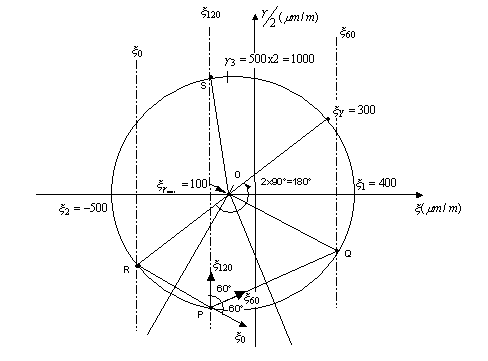As explained earlier, there can be numerous
configurations of rosettes arrangement and each case yields different solution
of  .
.
Hence, it will be ideal to have a technique which can solve for the principal
strains without having to obtain  and is applicable to a generic rosette arrangement.
and is applicable to a generic rosette arrangement.
This can be achieved by the technique
developed for Mohrís circle for strain rosettes.


Mohrís circle construction for strain
rosette.
Steps to construct a Mohrís circle
for strain rosette
- Set up the vertical axis to represent
 = 0 which is also the
= 0 which is also the  axis.
axis.
- Draw 3 parallel lines to the
 axis at the appropriate distances representing the values (+ve or -ve) of
axis at the appropriate distances representing the values (+ve or -ve) of  and
and  .
.
- On the middle line of these three (which is
the
 line for this case), mark a point P representing the origin of the rosette.
line for this case), mark a point P representing the origin of the rosette.
- Draw the rosette configuration at point P
with gauge C (for this case) in line with the
 line at Q and R.
line at Q and R.
- Construct perpendicular bisectors of PQ and
PR. Where these intersect is the center of the strain Mohrís circle, O.
- Draw the circle on this center, which of
course should pass through points P, Q and R. Insert the x-axis passing
through O and this is the
 axis.
axis.
- Join O to Q, R and S; where S is the
opposite point of P on the circle.
- Lines OQ, OR and OS represents the 3 gauges
on the circle where 2
 and 2
and 2 are the angles between the gauges.
are the angles between the gauges.
- From the circle, read off the required
strain values e.g.
 .
.
 can also be found by considering the appropriate angle
(
can also be found by considering the appropriate angle
( )
from gauge a.
)
from gauge a.
Example 8
Using Example 7, solve using Mohr's circle for strain rosette
Solution:


Notice that:
 which is the same as that obtained using equations in example 7.
which is the same as that obtained using equations in example 7.
- Principal strain solution are the same as
Mohrís circle solution using
 values as shown in Example 6.
values as shown in Example 6.
Hence, this construction technique of
Mohrís circle for strain rosettes is a very powerful technique in obtaining
principal strains without the constraint of using equations for each case of
rosettes configuration.
Previous
Back
![]() .
.![]() and is applicable to a generic rosette arrangement.
and is applicable to a generic rosette arrangement.


